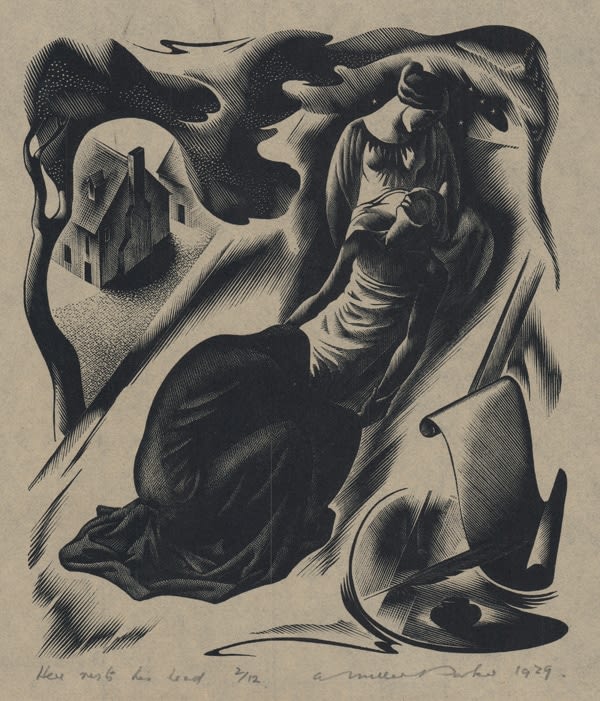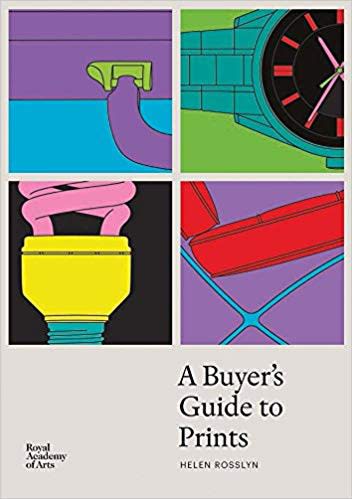Agnes Miller Parker
Here Rests His Head, 1939
Wood engraving
13.2 x 11.5 cm
5 1/4 x 4 1/2 in
5 1/4 x 4 1/2 in
Sanders of Oxford
Online only
Online only
£ 500.00
Signed, dated, numbered, and titled in pencil by the artist. Edition 2/12 An ethereal scene from the epitaph of ‘Elegy Written in a Country Church-Yard’ by Thomas Gray. The poem,...
Signed, dated, numbered, and titled in pencil by the artist. Edition 2/12
An ethereal scene from the epitaph of ‘Elegy Written in a Country Church-Yard’ by Thomas Gray. The poem, first published in 1751, tells the tale of the speaker as he calmly contemplates death in a rural graveyard at dusk. A memento mori, the speaker contemplates the lives of the people marked on the graves he is passing, commenting on the reality of death coming for us all disregarding social status. The poem ends with his own imagined epitaph for which this print was designed:
‘Here rests his head upon the lap of Earth
A youth to Fortune and to Fame unknown.
Fair Science frown'd not on his humble birth,
And Melancholy mark'd him for her own.’
The print shows the male figure at the moment of his death, his head resting on the lap of a female figure representing Earth. A figure cloaked in black is is seen at the mans feet grasping at his arm. To the right is an unfurled blank scroll, a quill, and a pot of ink representing the unwritten epitaph. To the left is a figurative tree swirling across the top of the scene, framing the print.
Agnes Miller Parker (1895–1980) was born in Ayrshire, Scotland and studied art at the Glasgow School of Art. She was primarily an illustrator and taught in London during the 1920’s. After marrying she worked at the Gregynog Press with her husband, William McCance, and her former tutors, Gertrude Hermes and Blair Hughes-Stanton. The main body of her work consists of wood-engravings for book illustrations that demonstrate fine draughtsmanship and skilful use of black and white design. She exhibited at the Society of Wood Engravers, of which she was a member and she illustrated books for Gregynog, Golden Cockerel Press and for Limited Editions Club of New York. She illustrated The Fables of Aesop (1931), Through the Woods by H. E. Bates (1936), The Open Air by Richard Jefferies (1949) and her most acclaimed work, Elegy Written in a Country Churchyard by Thomas Gray (1938).
Ex Col: Merlin Hanbury-Tracy, 7th Baron Sudeley.
Condition: Printed on fine Japon paper. Some toning from previous mount. Area of thinning to right sheet edge. Tape residue to verso from previous mount.
An ethereal scene from the epitaph of ‘Elegy Written in a Country Church-Yard’ by Thomas Gray. The poem, first published in 1751, tells the tale of the speaker as he calmly contemplates death in a rural graveyard at dusk. A memento mori, the speaker contemplates the lives of the people marked on the graves he is passing, commenting on the reality of death coming for us all disregarding social status. The poem ends with his own imagined epitaph for which this print was designed:
‘Here rests his head upon the lap of Earth
A youth to Fortune and to Fame unknown.
Fair Science frown'd not on his humble birth,
And Melancholy mark'd him for her own.’
The print shows the male figure at the moment of his death, his head resting on the lap of a female figure representing Earth. A figure cloaked in black is is seen at the mans feet grasping at his arm. To the right is an unfurled blank scroll, a quill, and a pot of ink representing the unwritten epitaph. To the left is a figurative tree swirling across the top of the scene, framing the print.
Agnes Miller Parker (1895–1980) was born in Ayrshire, Scotland and studied art at the Glasgow School of Art. She was primarily an illustrator and taught in London during the 1920’s. After marrying she worked at the Gregynog Press with her husband, William McCance, and her former tutors, Gertrude Hermes and Blair Hughes-Stanton. The main body of her work consists of wood-engravings for book illustrations that demonstrate fine draughtsmanship and skilful use of black and white design. She exhibited at the Society of Wood Engravers, of which she was a member and she illustrated books for Gregynog, Golden Cockerel Press and for Limited Editions Club of New York. She illustrated The Fables of Aesop (1931), Through the Woods by H. E. Bates (1936), The Open Air by Richard Jefferies (1949) and her most acclaimed work, Elegy Written in a Country Churchyard by Thomas Gray (1938).
Ex Col: Merlin Hanbury-Tracy, 7th Baron Sudeley.
Condition: Printed on fine Japon paper. Some toning from previous mount. Area of thinning to right sheet edge. Tape residue to verso from previous mount.





 A Buyer's Guide to Prints
A Buyer's Guide to Prints